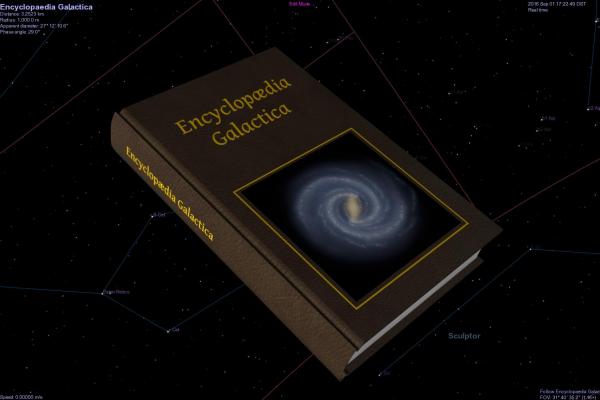BY LETTER
Encyclopædia Galactica, The
Culture and Society > Cultural Factors > Groups and Organizations
Culture and Society > Cultural Factors > Institutes
Culture and Society > Fine Arts > Narrative
Galactography > Civilized Galaxy - Sephirotic Empires > Negentropy Alliance
Culture and Society > Cultural Factors > Institutes
Culture and Society > Fine Arts > Narrative
Galactography > Civilized Galaxy - Sephirotic Empires > Negentropy Alliance
 Image from Selden Ball | |
| A virtual of the Encyclopaedia, capable of display in virtual and augmented reality environments. It is also possible to produce this as a physical copy which can update itself constantly (or more rarely, as a much reduced, static copy with no update functions) | |
History
Long before Terragen mindkind left the Earth behind, before electronic communications existed, even before the invention of the printing press, encyclopedic collections of the world's knowledge were disseminated to all who could afford them. For thousands of years, the Encyclopædia Galactica has followed in this long, proud tradition.Production
The Encyclopædia provides an organized reference to the sum total of Terragen knowledge. Edited by dedicated staff in the Encyclopædia Galactica Institute on Ken Ferjik and elsewhere, it includes articles on significant topics written by renowned teachers, philosophers and researchers. Most articles are authored by the leading experts on their topics. The accuracy of the information provided is then validated by transophic entities at the highest level.Encyclopædia Galactica Formats
Virtual
The standard method of accessing the Encyclopædia Galactica is by way of displays and other virtual services connected to the Known Net. While many of these services are publicly available, please contact any authorized representative of the Encyclopædia Galactica Institute to obtain your own personalized interface.The EG's informational interfaces make use of the highest bandwidth and lowest latency communication infrastructure to access the nearest of the Institute's information storage systems. Somewhat greater latency probably will be experienced if a query requires access to off-planet storage, including the Institute's central servers on Ken Ferjik and the secondary servers on Alexandria. Every system in the Negentropy Alliance maintains supplementary servers and Encyclopaedia research staff, as do many other worlds in the Inner Sphere and Hinter-regions.
Physical
The Institute is delighted to make available physical access systems for use in situations where there is minimal or no access to high bandwidth communications networks and associated display systems. These physical Encyclopædia Galactica systems can be obtained in a large variety of formats. One very popular design emulates the form of an ancient data storage system known as a "book." Although it appears to be much like one of the encyclopedias available to ancient man, this hardcopy version of the Encyclopædia Galactica is far more versatile.- Physical durability:
- Storage capacity:
- Data access protocols:
- Data presentation:
- Information updates:
 Image from Selden Ball | |
| A virtual Encyclopaedia can display 3D images and maps, as well as moving images and complex mathematical data in a variety of formats. | |
Disclaimers
The Encyclopædia Galactica Institute is not responsible for the results of any use made of the information provided in the the Encyclopædia. Each individual must make er's own decision as to the suitability of that information for er's situation.The Encyclopædia Galactica in any of its physical incarnations is not designed to be used as a substitute for The Encyclopaedia Everythingiana. Neither its physical durability nor its data content is likely to be appropriate. Use of the EG in events sponsored by the Institute of Survival probably will disqualify the contestant and the contestant's descendants. If any.
Availability
Although some polities may restrict the availability of the Encyclopædia Galactica, it can be accessed almost everywhere throughout the Terragen Sphere. Its contents are automatically translated into every language known to the Institute.You are currently reading one of the freely distributed versions of the Encyclopædia Galactica. Additional information about any of the topics mentioned above or elsewhere in this Encyclopædia is readily available through any of our licensed service providers. Communications and other fees may apply.
Local Versions
Local versions are maintained on most worlds in the Sephirotic Empires, and on many independent worlds; these local versions often contain data that is not included in the authorized version, and should be treated with caution (like any other source of data). Representatives of the Encyclopædia Galactica periodically review as many local versions as possible, both to remove controversial/inaccurate data and to collect new information for the master database in the Ken Ferjik system.Related Articles
Appears in Topics
Development Notes
Text by Selden Ball
additional material by Steve Bowers
Initially published on 21 September 2016.
additional material by Steve Bowers
Initially published on 21 September 2016.






